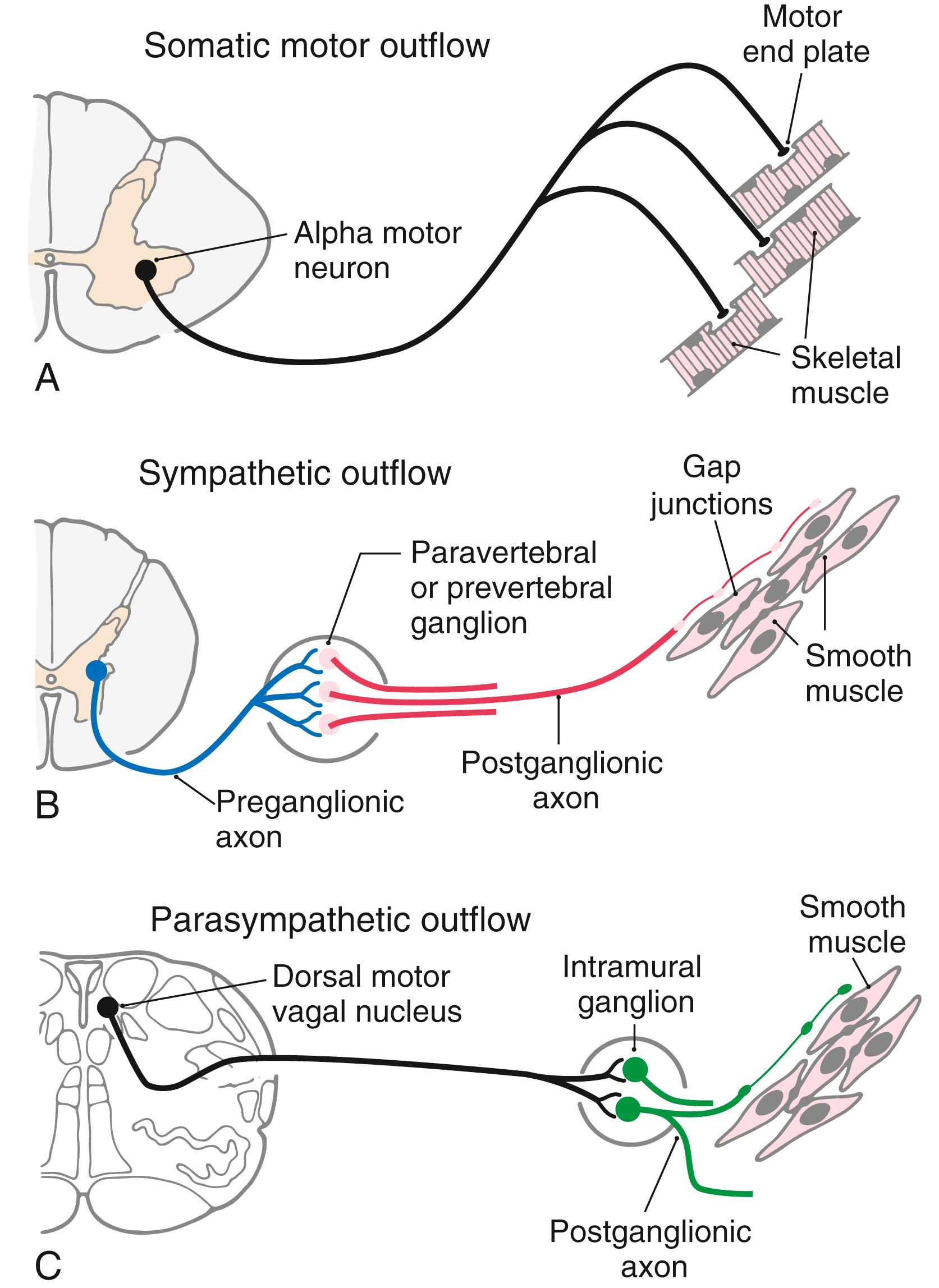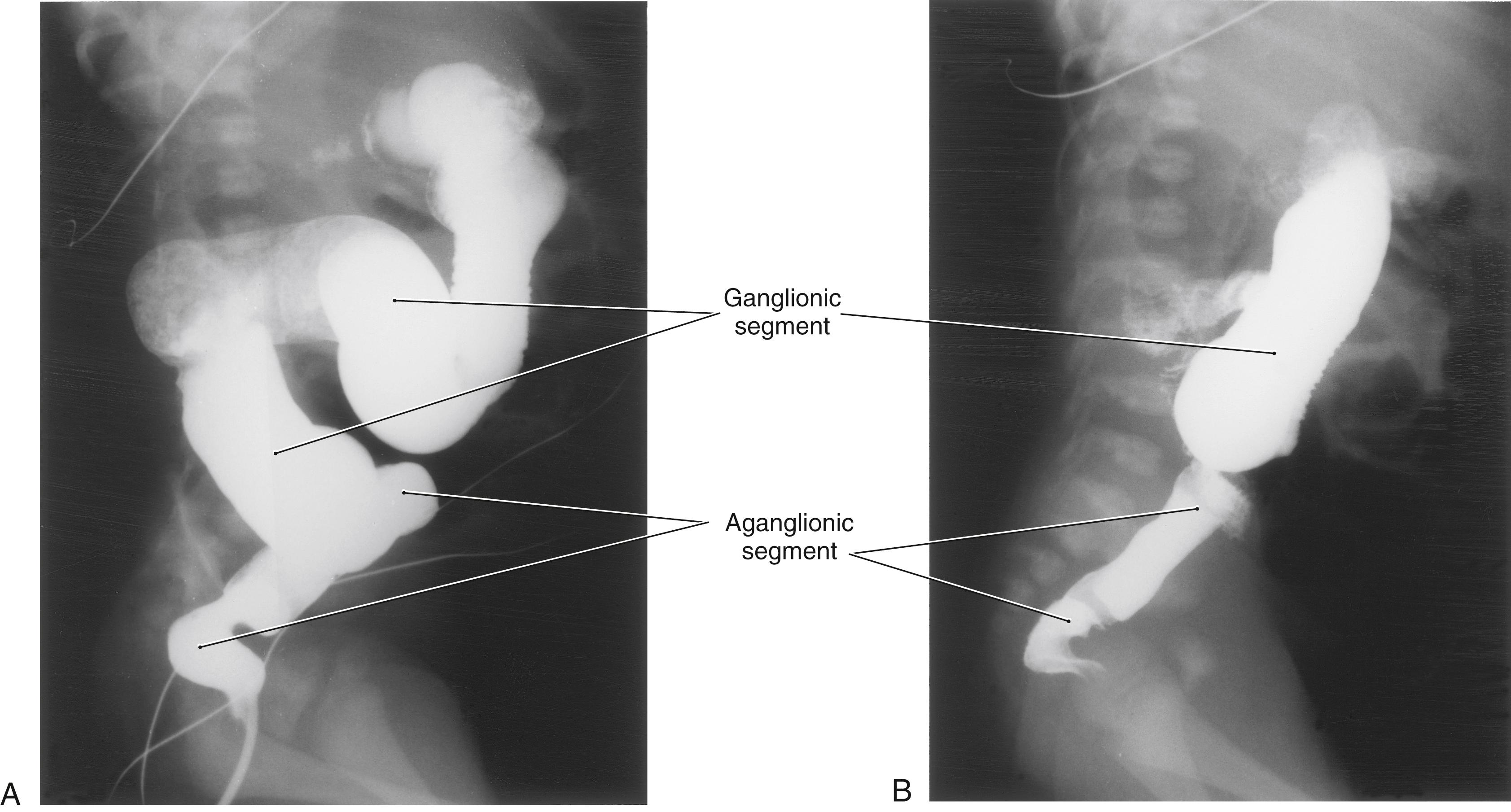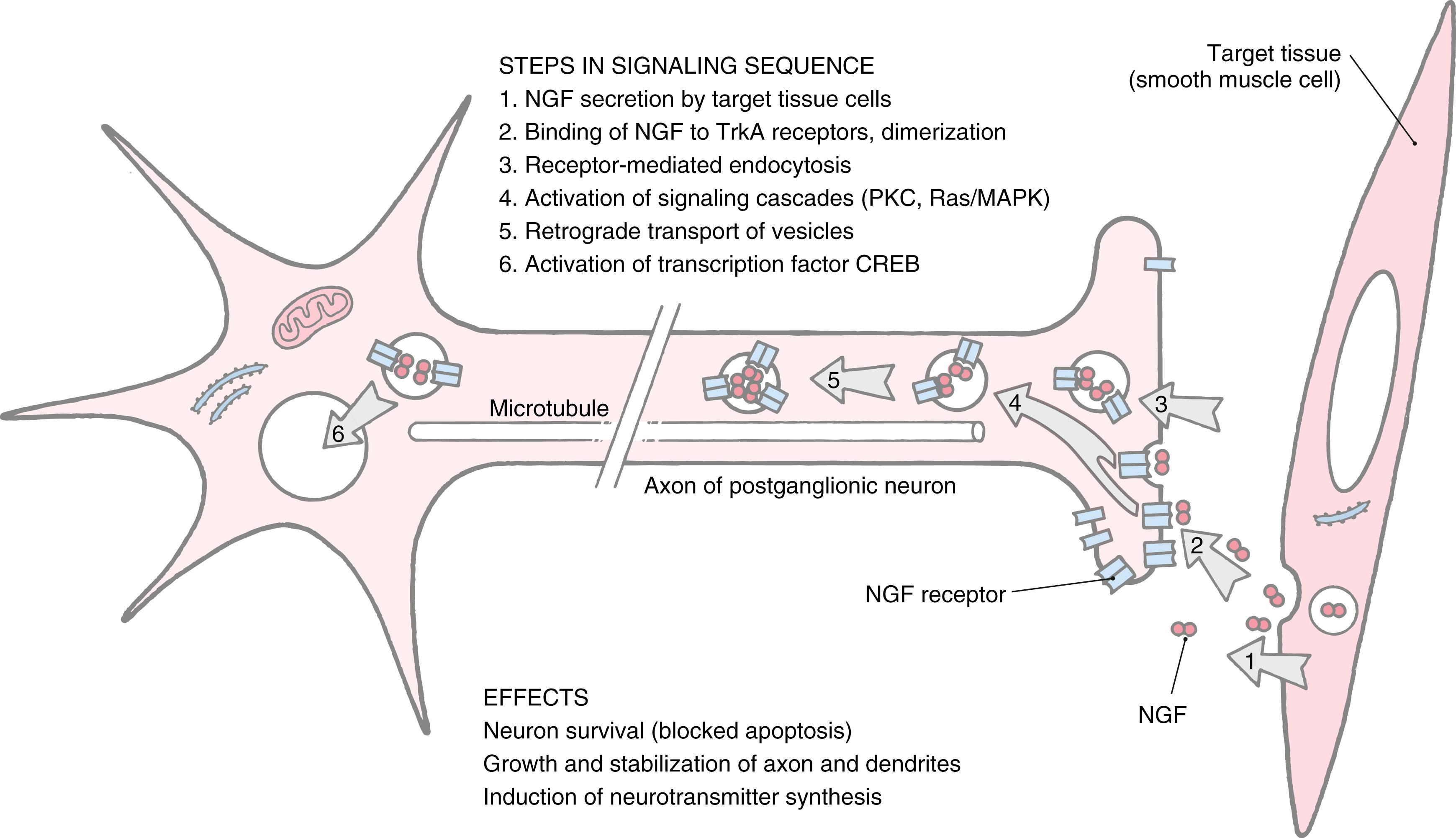Physical Address
304 North Cardinal St.
Dorchester Center, MA 02124
The primary function of the visceral motor system is the regulation of cardiovascular, respiratory, digestive, urinary, integumentary, and reproductive organs. These organs are the main effectors of homeostasis, the maintenance of a stable internal environment against perturbing influences, both external and internal. In general, visceral motor neurons innervate smooth and cardiac muscles and glandular epithelium or structures made up of combinations of these tissues.
The visceral motor ( autonomic ) system ensures that tissues of the body receive appropriate nutrients, electrolytes, and oxygen and that functions such as osmolarity and temperature are properly regulated. The nervous system contributes significantly to the control and coordination of homeostatic mechanisms in response to continually changing requirements. Two overlapping control systems influence visceral effectors. One is humoral ( endocrine ). Hormonal responses tend to develop slowly, but the effects are prolonged. The other system is a neural ( autonomic, visceral motor ) response that tends to be immediate, but the effects are short term.
The endocrine and autonomic systems are interdependent. They are both under the control of widely distributed central nervous system (CNS) structures, which generate commands after integrating inputs from a wide variety of sources. Thus visceral motor output is influenced by emotional status as well as by sensory signals reporting conditions inside and outside the body.
The visceral motor system has two major subdivisions, sympathetic and parasympathetic. In addition, neurons located in the wall of the alimentary canal form a somewhat autonomous component called the enteric nervous system. This is sometimes regarded as a third subdivision of the autonomic system. Within each of these components are populations of chemically coded, target-specific neurons.
The autonomic system provides neural control of smooth muscle, cardiac muscle, or glandular secretory cells of viscera located in body cavities and in some structures of the head, such as the iris ( Table 29.1 ). There are also visceral targets in the body wall and limbs. These are found in skeletal muscle (blood vessels) and in the skin (blood vessels, sweat glands, and arrector pili muscles). The sympathetic and parasympathetic divisions have overlapping and generally antagonistic influences; however, visceral structures of the body wall and extremities are generally regulated by the sympathetic division alone. The sympathetic outflow thus has a global distribution in that it innervates visceral structures in all parts of the body, whereas the parasympathetic outflow is restricted to targets in the head and body cavities ( Table 29.1 ).
| Physiologic Process | Sympathetic Stimulation | Parasympathetic Stimulation |
|---|---|---|
| Eye | ||
| Pupil diameter | + | − |
| Lens refraction | 0 | + |
| Palpebral fissure width | + | 0 |
| Tear flow | 0 | + |
| Salivary gland flow | − | + |
| Skin | ||
| Piloerection | + | 0 |
| Sweating | + | 0 |
| Blood flow | − | 0 |
| Skeletal muscle blood flow | ± | 0 |
| Cardiovascular System | ||
| Cardiac output | + | − |
| Total peripheral resistance | + | 0 |
| Bronchial diameter | + | − |
| Gut | ||
| Peristalsis | − | + |
| Secretion | − | + |
| Sphincter tone | + | − |
| Blood flow | − | + |
| Liver glycogenolysis | + | 0 |
| Pancreatic insulin secretion | − | + |
| Pancreatic glucagon secretion | + | + |
| Urinary bladder detrusor tone | − | + |
| Internal urethral sphincter tone | + | - |
| Penile or clitoral erection | 0 | + |
| Ejaculation | + | 0 |
There are similarities and differences between the neural control of skeletal muscle and visceral effectors, such as smooth muscle ( Fig. 29.1 ). As described in Chapter 24 , lower motor neurons (alpha motor neurons) function as the final common pathway linking the CNS to skeletal muscle fibers ( Fig. 29.1 A ). Similarly, sympathetic and parasympathetic outflows serve as the final but often dual common neural pathway from the CNS to visceral effectors. However, unlike the somatic motor system, the peripheral visceral motor pathway consists of two neurons ( Fig. 29.1 B, C ). The first, the preganglionic neuron, has its cell body in either the brainstem or the spinal cord. Its axon projects as a thinly myelinated preganglionic fiber to an autonomic ganglion. The second, the postganglionic neuron, has its cell body in an autonomic ganglion and sends an unmyelinated axon ( postganglionic fiber ) to visceral effector cells, such as smooth muscle. In general, parasympathetic ganglia are located close to the effector tissue, and sympathetic ganglia are close to the CNS. Consequently, parasympathetic pathways typically have long preganglionic fibers and short postganglionic fibers, whereas sympathetic pathways more often have short preganglionic fibers and long postganglionic fibers.

Visceral motor neurons and their targets are not organized into discrete motor units like those of the somatic motor system. Recall that an alpha motor neuron makes synaptic contacts with a definite group of skeletal muscle fibers over which it has exclusive control. In contrast, the terminal branches of a postganglionic visceral motor axon typically have a series of swellings containing neurotransmitter vesicles along their length, giving them a beaded (varicose) appearance ( Fig. 29.1 B, C ). The neurotransmitters released from these terminals may act on effector cells at a distance of up to 100 μm. Moreover, unlike skeletal muscle fibers, cardiac muscle fibers and the smooth muscle cells of some organs are electrically coupled by gap junctions. Because of this, neurochemical signaling to a few cells is sufficient to regulate a large group of cells that act as a unit. The main features of sympathetic and parasympathetic divisions are summarized in Table 29.2 .
| Feature | Sympathetic (Thoracolumbar) | Parasympathetic (Craniosacral) |
|---|---|---|
| Location of preganglionic cell bodies | Spinal cord segments T1 to L2, mainly intermediolateral cell column | Spinal cord segments S2 to S4, intermediate gray; plus visceral efferent nuclei of cranial nerves III, VII, IX, X |
| Location of preganglionic nerve fibers | White rami T1 to L2, sympathetic trunks, splanchnic nerves | Pelvic nerves; cranial nerves III, VII, IX, X |
| Location of postganglionic cell bodies | Paravertebral ganglia, prevertebral ganglia (celiac, aorticorenal, superior mesenteric, inferior mesenteric) | Ganglion cell clusters in walls of viscera, cranial nerve autonomic ganglia (ciliary—III; pterygopalatine and submandibular—VII; otic—IX) |
| Location of postganglionic nerve fibers | Fibers to structures of body wall and limbs in gray rami and spinal nerves, plexuses associated with arteries supplying visceral structures of the head and body cavities | Within the viscera of body cavities; short nerves or plexuses extending from cranial ganglia to target organs; often accompany trigeminal nerve branches in head |
| Target effectors | Smooth muscle, cardiac muscle, and secretory cells throughout body; blood vessels of body wall and of head | Mostly viscera of the head and the thoracic, abdominal, and pelvic cavities |
| Primary neurotransmitter of preganglionic neurons | Acetylcholine | Acetylcholine |
| Primary neurotransmitter of postganglionic neurons | Norepinephrine; cells supplying sweat glands use acetylcholine | Acetylcholine |
| Neuropeptides of postganglionic neurons | Neuropeptide Y and others | Vasoactive intestinal peptide and others |
| General physiologic effects | Mobilization of resources for activity | Promotion of restorative processes |
Cell bodies of these multipolar neurons are located in nuclei or cell columns embryologically derived from the visceral efferen t cell column. This column arises from neuroblasts in the basal (motor) plate of the brainstem and spinal cord portions of the neural tube.
Cell bodies of these multipolar neurons are located in autonomic ganglia, which may be either well-defined, encapsulated structures, such as the superior cervical ganglion, or clusters of somata found in nerve plexuses or in the walls and capsules of visceral organs. Like primary sensory neurons, autonomic ganglion cells are derived from neural crest cells that migrate to appropriate locations during development.
One result of this cell migration is the advent, in the adult, of the myenteric ( Auerbach ) and the submucosal ( Meissner ) plexuses and the normal muscular and secretory functions of the intestinal wall.
Congenital megacolon, or Hirschsprung disease, results from a failure of these enteric neuronal precursor cells to migrate into the wall of the developing lower gut. As a result, the affected segment of the gut (the portion lacking enteric ganglion cells, the aganglionic segment ), usually the colon, is paralyzed in a constricted state, with consequent distention of the proximal and normally innervated portion of the intestine (the portion containing enteric ganglion cells, the ganglionic segment ) ( Fig. 29.2 ). This disease is most commonly diagnosed in the very young (newborn to 3 years) but on occasion may not be diagnosed until adulthood. Although the presentation of the disease is strikingly characteristic on a radiograph or with magnetic resonance imaging ( Fig. 29.2 ), definitive diagnosis relies on a biopsy and histologic confirmation of a lack of enteric ganglion neurons in the affected segment. The treatment of choice is to resect the aganglionic segment and join the remaining functional portions of the gut.

Development of the autonomic nervous system requires an elaborate sequence of intercellular signaling that involves two major families of neurotrophic factors. One is the glial cell line–derived neurotrophic factor (GDNF) family, which consists of several distinct signaling molecules and their receptors. Mutations of one of these receptors, designated RET (rearranged during transfection), is the underlying cause of some cases of congenital megacolon. The neurotrophins are the other large family of neurotrophic factors. As with the GDNF family, each neurotrophin regulates development and function of specific populations of peripheral nervous system and CNS neurons via binding to specific receptors. The existence of these neuronal growth factors was first demonstrated when the neurotrophin nerve growth factor (NGF) was discovered as a target-derived messenger molecule that is absolutely essential for survival and development of sympathetic postganglionic neurons ( Fig. 29.3 ) as well as those primary sensory neurons that are involved in pain ( Fig. 29.3 ). Of interest, mutations in the NGF gene and tropomyosin-related kinase A (TrkA), the receptor for NGF, have been identified in patients with the autosomal recessive disorder hereditary sensory and autonomic neuropathy ( HSAN ) type IV and HSAN type V, respectively (also referred to as congenital insensitivity to pain ).

Become a Clinical Tree membership for Full access and enjoy Unlimited articles
If you are a member. Log in here